Sustainable Development of Life Service Resources: A New Framework Based on GIScience and Spatial Justice
Abstract
:1. Introduction
2. Theoretical Analysis Framework
2.1. Why Should SJ Be Considered When Studying LSRs?
2.2. How Should SJ Be Applied and Interpreted for LSRs?
3. Data and Methods
3.1. Area Description
3.2. Research Methods
3.2.1. Descriptive Statistics
3.2.2. Information Entropy
3.2.3. Spatial Analysis Method
3.2.4. Coupling Coordination Degree Model
3.3. Data Sources and Processing
4. Results
4.1. Quantity Dimension
4.2. Structure Dimension
4.3. Pattern Dimension
4.4. Coupling Coordination Dimension
5. Discussion
5.1. SJ of LSRs Reflected by Coupling Coordination Degree
5.2. The LSRs among Beijing and London: Distributive Injustice
5.3. The Future of SJ Theory: Spatial Analysis and Big Data
5.4. Spatial Difference of LSRs: Market Mechanism and Government Power
5.5. Limitations and Directions for Future Research
6. Conclusions and Policy Recommendations
- (1)
- The development gap needs to be reduced between the north and south. Here, Beijing’s LSRs have gradually formed an axial development pattern, and the north–south difference in LSRs is more significant than the east–west. Therefore, future LSR development should pay attention to the north–south difference, increasing investment in areas south of Chang’an Avenue. Furthermore, the distribution of LSRs around subway stations and subway lines tells us that improving transportation facilities is significant for achieving fairness in resource distribution.
- (2)
- The spatial differences for catering services need to be addressed. The number of catering services facilities in Chaoyang District is almost 10 times that of Shijingshan District. Given that catering services are a dominant type of LSRs, this paper suggests that policymakers need to provide more catering services in Shijingshan District. This does not mean that the government should directly fund the development of catering services. Still, it can help by providing more policy support for companies and individuals that provide catering services, such as providing sufficient land supply, guiding the agglomeration of catering companies, and creating a food street or plaza with scale effect.
- (3)
- Accommodation services could be combined with reconstructing old urban areas and the new construction of satellite cities. As a cultural symbol of Beijing, Hutong has played a crucial residential function to this day. However, due to the poor conditions of the public infrastructure, this area urgently needs renovation [83]. Some residents want to move out of the crowded hutongs, while others hope to transform the hutongs into hotels. Therefore, residents, planners, companies, and the government could work together to transform the old city and the construction of the satellite city. This embodies the procedural justice in SJ. Hence, the government should guide the orderly development of accommodation service facilities by formulating industry development plans.
- (4)
- As the old Chinese saying goes, “Loving beauty is part of human nature”. To facilitate residents’ access to beauty salon services, policymakers should consider establishing at least one beauty salon in each community. Currently, beauty salon services in Beijing are centralized in the junction area of Dongcheng, Chaoyang, and Fengtai Districts. As a result, a longer commute is required for residents outside of these areas to access these services. In addition, building beauty salons can increase the vitality of the urban area by increasing the diversity of consumption in the neighbourhood, which is another way to improve the life service resources.
- (5)
- Although the total number of POIs for dyeing, appliance repair, and portrait photography accounts for less than 10% of LSRs, existing services placement should be considered when establishing new service locations. Based on the results of the spatial pattern, there are fewer dyeing services in the northwest of the studied area. In contrast, appliance repair and portrait photography services tended to be found in the eastern region. The results of the coupling and coordination degrees in the current study reflect the unbalanced spatial distribution of these services in Beijing. Therefore, corresponding LSRs should be added in the above areas.
Author Contributions
Funding
Institutional Review Board Statement
Informed Consent Statement
Data Availability Statement
Conflicts of Interest
References
- United Nations. Transforming Our World: The 2030 Agenda for Sustainable Development. 2015. Available online: https://sustainabledevelopment.un.org/content/documents/21252030%20Agenda%20for%20Sustainable%20Development%20web.pdf (accessed on 20 April 2022).
- United Nations. World Urbanization Prospects. Available online: https://www.un.org/development/desa/publications/2018-revision-of-world-urbanization-prospects.html (accessed on 20 April 2022).
- Yu, H. Pay close attention to and take measures to accelerate the development of life service industry. China Econ. Trade Her. 2012, 29, 27–30. [Google Scholar]
- State Council. Guiding Opinions on Accelerating the Development of Life Service Industry and Promoting the Upgrading of Consumption Structure. Available online: http://www.gov.cn/zhengce/content/2015-11/22/content_10336.htm (accessed on 20 April 2022).
- Ministry of Commerce. Thirteenth Five-Year Plan for the Development of Residents’ Life Service Industry. Available online: http://www.mofcom.gov.cn/article/guihua/201701/20170102495671.shtml (accessed on 20 April 2022).
- Ministry of Finance and State Taxation Administration. Announcement on Clarifying the Policy of Adding and Deducting Value-Added Tax of Life Service Industry. Available online: http://www.chinatax.gov.cn/chinatax/n810341/n810755/c5137754/content.html (accessed on 20 April 2022).
- National Development and Reform Commission. Notice on Several Opinions on Promoting the Life Service Industry to Make Up for Shortcomings and Improve People’s Quality of Life. Available online: http://www.gov.cn/zhengce/content/2021-11/02/content_5648192.htm (accessed on 20 April 2022).
- Weziak-Bialowolska, D. Quality of life in cities—Empirical evidence in comparative European perspective. Cities 2016, 58, 87–96. [Google Scholar] [CrossRef]
- Zhao, Z.; Pang, R.; Wang, S. Measurement of spatial accessibility performance of large retailing facilities in Changchun. Geogr. Res. 2016, 35, 431–441. [Google Scholar]
- De Vita, A. Inequality and poverty in global perspective. In Freedom from Poverty as a Human Right; Oxford University Press: New York, NY, USA, 2007; pp. 103–132. [Google Scholar]
- Christman, B.; Russell, H. Readjusting the political thermostat: Fuel poverty and human rights in the UK. J. Hum. Rights Commonw. 2016, 2, 116–128. [Google Scholar] [CrossRef]
- Macintyre, S. Deprivation amplification revisited; or, is it always true that poorer places have poorer access to resources for healthy diets and physical activity? Int. J. Behav. Nutr. Phys. Act. 2007, 4, 1–7. [Google Scholar] [CrossRef] [Green Version]
- Reidpath, D.D.; Burns, C.; Garrard, J.; Mahoney, M.; Townsend, M. An ecological study of the relationship between social and environmental determinants of obesity. Health Place 2002, 8, 141–145. [Google Scholar] [CrossRef]
- Wardle, H.; Keily, R.; Astbury, G.; Reith, G. “Risky Places?”: Mapping gambling machine density and socio-economic deprivation. J. Gambl. Stud. 2014, 30, 201–212. [Google Scholar] [CrossRef]
- Macdonald, L.; Olsen, J.R.; Shortt, N.K.; Ellaway, A. Do “environmental bads” such as alcohol, fast food, tobacco, and gambling outlets cluster and co-locate in more deprived areas in Glasgow City, Scotland? Health Place 2018, 51, 224–231. [Google Scholar] [CrossRef]
- Yen, I.H.; Kaplan, G.A. Neighborhood social environment and risk of death: Multilevel evidence from the Alameda County Study. Am. J. Epidemiol. 1999, 149, 898–907. [Google Scholar] [CrossRef]
- Anguelovski, I.; Cole, H.V.S.; O’Neill, E.; Baro, F.; Kotsila, P.; Sekulova, F.; Perez Del Pulgar, C.; Shokry, G.; Garcia-Lamarca, M.; Arguelles, L.; et al. Gentrification pathways and their health impacts on historically marginalized residents in Europe and North America: Global qualitative evidence from 14 cities. Health Place 2021, 72, 102698. [Google Scholar] [CrossRef]
- Buzzacchi, L.; Leveque, P.; Taramino, R.; Zotteri, G. Using betweenness metrics to investigate the geographical distribution of retailers. Environ. Plan. B-Urban Anal. City Sci. 2021, 48, 2221–2238. [Google Scholar] [CrossRef]
- Lv, Y.; Zheng, X.; Zhou, L. Relationships between street centrality and spatial distribution of functional urban land use: A case study of Beijing central city. Geogr. Res. 2017, 36, 1353–1363. [Google Scholar]
- Wu, M.; Pei, T.; Wang, W.; Guo, S.; Song, C.; Chen, J.; Zhou, C. Roles of locational factors in the rise and fall of restaurants: A case study of Beijing with POI data. Cities 2021, 113, 103185. [Google Scholar] [CrossRef]
- Ning, X.; Liu, Y.; Wang, H.; Hao, M.; Yang, B.; Wang, M. Research on Functional Land Division of the Main Urban Area in Beijing Based on Crowd Sourcing Geographic Data. Geogr. Geo-Inf. Sci. 2018, 34, 42–49. [Google Scholar]
- Jiang, B.; Wang, Y.; Ye, X. Detecting development pattern of urban business facilities using reviews data. Acta Geod. Cartogr. Sin. 2015, 44, 1022–1028. [Google Scholar]
- Wang, T.; Wang, Y.; Zhao, X.; Fu, X. Spatial distribution pattern of the customer count and satisfaction of commercial facilities based on social network review data in Beijing, China. Comput. Environ. Urban Syst. 2018, 71, 88–97. [Google Scholar] [CrossRef]
- Lee, J.P.; Ponicki, W.; Mair, C.; Gruenewald, P.; Ghanem, L. What explains the concentration of off-premise alcohol outlets in Black neighborhoods? SSM-Popul. Health 2020, 12, 669. [Google Scholar] [CrossRef]
- Fang, Y.; Mao, J.; Liu, Q.; Huang, J. Exploratory space data analysis of spatial patterns of large-scale retail commercial facilities: The case of Gulou District, Nanjing, China. Front. Archit. Res. 2021, 10, 17–32. [Google Scholar] [CrossRef]
- Wang, F.; Chen, C.; Xiu, C.; Zhang, P. Location analysis of retail stores in Changchun, China: A street centrality perspective. Cities 2014, 41, 54–63. [Google Scholar] [CrossRef]
- Pirie, G.H. On spatial justice. Environ. Plan. A 1983, 15, 465–473. [Google Scholar] [CrossRef]
- Smith, D.M. Geography and Social Justice; Blackwell: Oxford, UK, 1994. [Google Scholar]
- Israel, E.; Frenkel, A. Social justice and spatial inequality: Toward a conceptual framework. Prog. Hum. Geogr. 2018, 42, 647–665. [Google Scholar] [CrossRef]
- Soja, E.W. The city and spatial justice. In Justice et Injustices Spatiales; Presses Universitaires de Paris Nanterre: Nanterre, France, 2016; pp. 56–72. [Google Scholar]
- Bouzarovski, S.; Simcock, N. Spatializing energy justice. Energy Policy 2017, 107, 640–648. [Google Scholar] [CrossRef]
- Sovacool, B.K.; Heffron, R.J.; McCauley, D.; Goldthau, A. Energy decisions reframed as justice and ethical concerns. Nat. Energy 2016, 1, 1–6. [Google Scholar] [CrossRef] [Green Version]
- Guerra, E.; Kirschen, M. Housing Plus Transportation Affordability Indices: Uses, Opportunities, and Challenges. Available online: https://www.econstor.eu/handle/10419/173922 (accessed on 20 April 2022).
- Jian, I.Y.; Luo, J.; Chan, E.H.W. Spatial justice in public open space planning: Accessibility and inclusivity. Habitat Int. 2020, 97, 102122. [Google Scholar] [CrossRef]
- Deb, D.; Smith, R.M. Application of Random Forest and SHAP Tree Explainer in Exploring Spatial (In)Justice to Aid Urban Planning. ISPRS Int. J. Geo-Inf. 2021, 10, 629. [Google Scholar] [CrossRef]
- Ewing, R.; Hamidi, S.; Grace, J.B.; Wei, Y.D. Does urban sprawl hold down upward mobility? Landsc. Urban Plan. 2016, 148, 80–88. [Google Scholar] [CrossRef] [Green Version]
- Getis, A.; Mur, J.; Zoller, H.; Mur, J.; Fingleton, B.; Smith, T.; Plotnikova, M. Spatial Econometrics and Spatial Statistics. Available online: http://citeseerx.ist.psu.edu/viewdoc/download?doi=10.1.1.175.681&rep=rep1&type=pdf (accessed on 20 April 2022).
- Lloyd, C. Spatial Data Analysis: An Introduction for GIS Users; Oxford University Press: New York, NY, USA, 2010. [Google Scholar]
- Szewranski, S.; Kazak, J.; Sylla, M.; Swiader, M. Spatial data analysis with the use of ArcGIS and Tableau systems. In The Rise of Big Spatial Data; Springer: Cham, Switzerland, 2017; pp. 337–349. [Google Scholar]
- Fainstein, S.S. The just city. Int. J. Urban Sci. 2014, 18, 1–18. [Google Scholar] [CrossRef]
- Lefebvre, H.; Nicholson-Smith, D. The Production of Space; Blackwell: Oxford, UK, 1991; Volume 142. [Google Scholar]
- Harvey, D. Social Justice and the City; University of Georgia Press: Athens, GA, USA, 2010; Volume 1. [Google Scholar]
- Soja, E.W. Postmodern Geographies: The Reassertion of Space in Critical Social Theory; Verso: London, UK, 1989. [Google Scholar]
- Maslow, A.H. A theory of human motivation. Psychol. Rev. 1943, 50, 370–396. [Google Scholar] [CrossRef] [Green Version]
- Zheng, R. On Spatial Justice: The Reconstruction of Justice and the Criticism of Spatial Production; Shanghai Academy of Social Sciences Press: Shanghai, China, 2018. [Google Scholar]
- Ernstson, H. The social production of ecosystem services: A framework for studying environmental justice and ecological complexity in urbanized landscapes. Landsc. Urban Plan. 2013, 109, 7–17. [Google Scholar] [CrossRef] [Green Version]
- McConnachie, M.M.; Shackleton, C.M. Public green space inequality in small towns in South Africa. Habitat Int. 2010, 34, 244–248. [Google Scholar] [CrossRef] [Green Version]
- Tsou, K.W.; Hung, Y.T.; Chang, Y.L. An accessibility-based integrated measure of relative spatial equity in urban public facilities. Cities 2005, 22, 424–435. [Google Scholar] [CrossRef]
- Kronenberg, J.; Haase, A.; Laszkiewicz, E.; Antal, A.; Baravikova, A.; Biernacka, M.; Dushkova, D.; Filcak, R.; Haase, D.; Ignatieva, M.; et al. Environmental justice in the context of urban green space availability, accessibility, and attractiveness in postsocialist cities. Cities 2020, 106, 102862. [Google Scholar] [CrossRef]
- Beiler, M.O.; Mohammed, M. Exploring transportation equity: Development and application of a transportation justice framework. Transp. Res. Part D-Transp. Environ. 2016, 47, 285–298. [Google Scholar] [CrossRef]
- Gu, C.; Kesteloot, C. Social polarisation and segregation phenomenon in Beijing. Acta Geogr. Sin. 1997, 52, 385–393. [Google Scholar]
- Feng, J.; Zhong, Y. Restructuring of social space in Beijing from 2000 to 2010. Acta Geogr. Sin. 2018, 73, 711–737. [Google Scholar]
- Huang, X.; Chen, Z. The retail business structure of the metro site based on the information entropy–a case study of the 15 subway site in Guangzhou. Econ. Geogr. 2014, 3, 38–44. [Google Scholar]
- Ebdon, D. Statistics in Geography; Blackwell Publishing: Hoboken, NJ, USA, 1985. [Google Scholar]
- Wenhao, Y.; Tinghua, A. The visualization and analysis of POI features under network space supported by kernel density estimation. Acta Geod. Cartogr. Sin. 2015, 44, 82. [Google Scholar]
- Borruso, G. Network density estimation: A GIS approach for analysing point patterns in a network space. Trans. GIS 2008, 12, 377–402. [Google Scholar] [CrossRef]
- Duan, Y.; Liu, Y.; Liu, X.; Wang, H. Identification of polycentric urban structure of central Chongqing using points of interest Big Data. J. Nat. Resour. 2018, 33, 788–800. [Google Scholar]
- Lefever, D.W. Measuring geographic concentration by means of the standard deviational ellipse. Am. J. Sociol. 1926, 32, 88–94. [Google Scholar] [CrossRef]
- Zhao, L.; Zhao, Z. Projecting the spatial variation of economic based on the specific ellipses in China. Sci. Geogr. Sin. 2014, 34, 979–986. [Google Scholar]
- Wang, J.; Wang, S.; Li, S.; Feng, K. Coupling analysis of urbanization and energy-environment efficiency: Evidence from Guangdong province. Appl. Energy 2019, 254, 113650. [Google Scholar] [CrossRef]
- Neutens, T.; Delafontaine, M.; Scott, D.M.; De Maeyera, P. A GIS-based method to identify spatiotemporal gaps in public service delivery. Appl. Geogr. 2012, 32, 253–264. [Google Scholar] [CrossRef] [Green Version]
- Nordberg, K. Spatial Justice and local capability in rural areas. J. Rural Stud. 2020, 78, 47–58. [Google Scholar] [CrossRef]
- Sun, F.; Zhang, J.; Ma, J.; Wang, C.; Hu, S.; Xu, D. Evolution of the Spatial-Temporal Pattern and Social Performance Evaluation of Community Sports and Fitness Venues in Shanghai. Int. J. Environ. Res. Public Health 2022, 19, 274. [Google Scholar] [CrossRef]
- Fisher, J.B.; Kelly, M.; Romm, J. Scales of environmental justice: Combining GIS and spatial analysis for air toxics in West Oakland, California. Health Place 2006, 12, 701–714. [Google Scholar] [CrossRef]
- Xu, F.; Hu, M.; La, L.; Wang, J.; Huang, C. The influence of neighbourhood environment on Airbnb: A geographically weighed regression analysis. Tour. Geogr. 2020, 22, 192–209. [Google Scholar] [CrossRef]
- Greater London Authority. London Borough Profiles and Atlas. Available online: https://data.london.gov.uk/dataset/london-borough-profiles (accessed on 20 April 2022).
- Lees, L.; Ferreri, M. Resisting gentrification on its final frontiers: Learning from the Heygate Estate in London (1974–2013). Cities 2016, 57, 14–24. [Google Scholar] [CrossRef] [Green Version]
- Liu, Y.; Wu, F.; Liu, Y.; Li, Z. Changing neighbourhood cohesion under the impact of urban redevelopment: A case study of Guangzhou, China. Urban Geogr. 2017, 38, 266–290. [Google Scholar] [CrossRef] [Green Version]
- Zhao, P. Too complex to be managed? New trends in peri-urbanisation and its planning in Beijing. Cities 2013, 30, 68–76. [Google Scholar] [CrossRef]
- Times, G. Construction of 50 Key Villages in the Urban-Rural Fringe of Beijing. Available online: https://china.huanqiu.com/article/9CaKrnJvCIx (accessed on 20 April 2022).
- McEntee, J.C.; Ogneva-Himmelberger, Y. Diesel particulate matter, lung cancer, and asthma incidences along major traffic corridors in MA, USA: A GIS analysis. Health Place 2008, 14, 817–828. [Google Scholar] [CrossRef] [PubMed]
- Hashem, I.A.T.; Chang, V.; Anuar, N.B.; Adewole, K.; Yaqoob, I.; Gani, A.; Ahmed, E.; Chiroma, H. The role of big data in smart city. Int. J. Inf. Manag. 2016, 36, 748–758. [Google Scholar] [CrossRef] [Green Version]
- Henar Salas-Olmedo, M.; Moya-Gomez, B.; Carlos Garcia-Palomares, J.; Gutierrez, J. Tourists’ digital footprint in cities: Comparing Big Data sources. Tour. Manag. 2018, 66, 13–25. [Google Scholar] [CrossRef] [Green Version]
- Li, J.; Li, J.; Yuan, Y.; Li, G. Spatiotemporal distribution characteristics and mechanism analysis of urban population density: A case of Xi’an, Shaanxi, China. Cities 2019, 86, 62–70. [Google Scholar] [CrossRef]
- Zhao, P.; Hu, H. Geographical patterns of traffic congestion in growing megacities: Big data analytics from Beijing. Cities 2019, 92, 164–174. [Google Scholar] [CrossRef]
- Liu, X.; Yan, X.; Wang, W.; Titheridge, H.; Wang, R.; Liu, Y. Characterizing the polycentric spatial structure of Beijing Metropolitan Region using carpooling big data. Cities 2021, 109, 103040. [Google Scholar] [CrossRef]
- Cremer, H.; Dekerchove, A.M.; Thisse, J.F. An economic-theory of public facilities in space. Math. Soc. Sci. 1985, 9, 249–262. [Google Scholar] [CrossRef]
- Onokerhoraye, A.G. A conceptual framework for the location of public facilities in the urban areas of developing countries: The Nigerian case. Socio-Econ. Plan. Sci. 1976, 10, 237–240. [Google Scholar] [CrossRef]
- Warr, P.; Menon, J.; Rasphone, S. Public services and the poor in Laos. World Dev. 2015, 66, 371–382. [Google Scholar] [CrossRef]
- Kawakami, N.; Winkleby, M.; Skog, L.; Szulkin, R.; Sundquist, K. Differences in neighborhood accessibility to health-related resources: A nationwide comparison between deprived and affluent neighborhoods in Sweden. Health Place 2011, 17, 132–139. [Google Scholar] [CrossRef]
- Estoque, R.C. A Review of the Sustainability Concept and the State of SDG Monitoring Using Remote Sensing. Remote Sens. 2020, 12, 1770. [Google Scholar] [CrossRef]
- Pereira, R.H.M.; Schwanen, T.; Banister, D. Distributive justice and equity in transportation. Transp. Rev. 2017, 37, 170–191. [Google Scholar] [CrossRef]
- Zacharias, J.; Sun, Z.; Chuang, L.; Lee, F. The hutong urban development model compared with contemporary suburban development in Beijing. Habitat Int. 2015, 49, 260–265. [Google Scholar] [CrossRef]
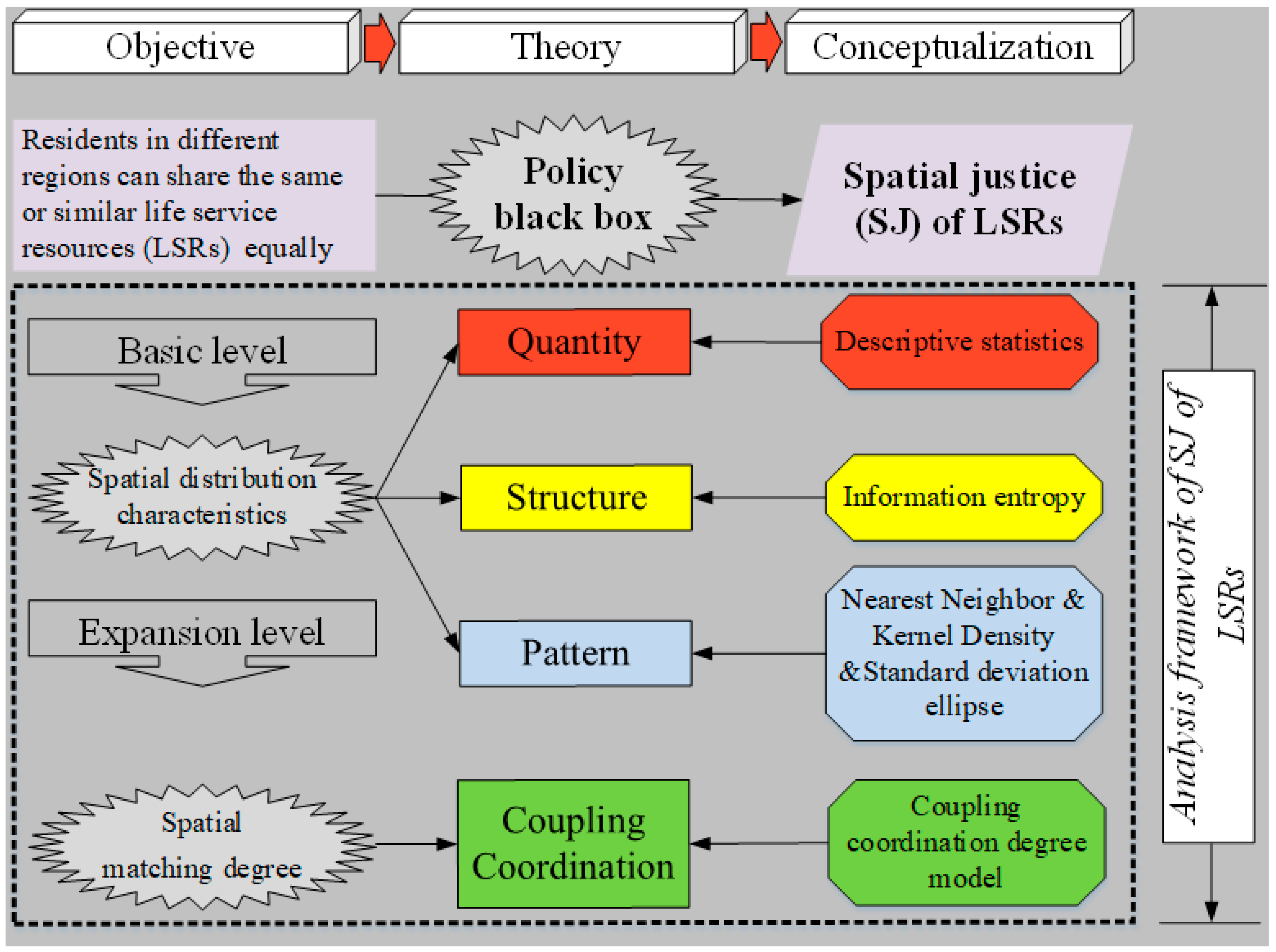
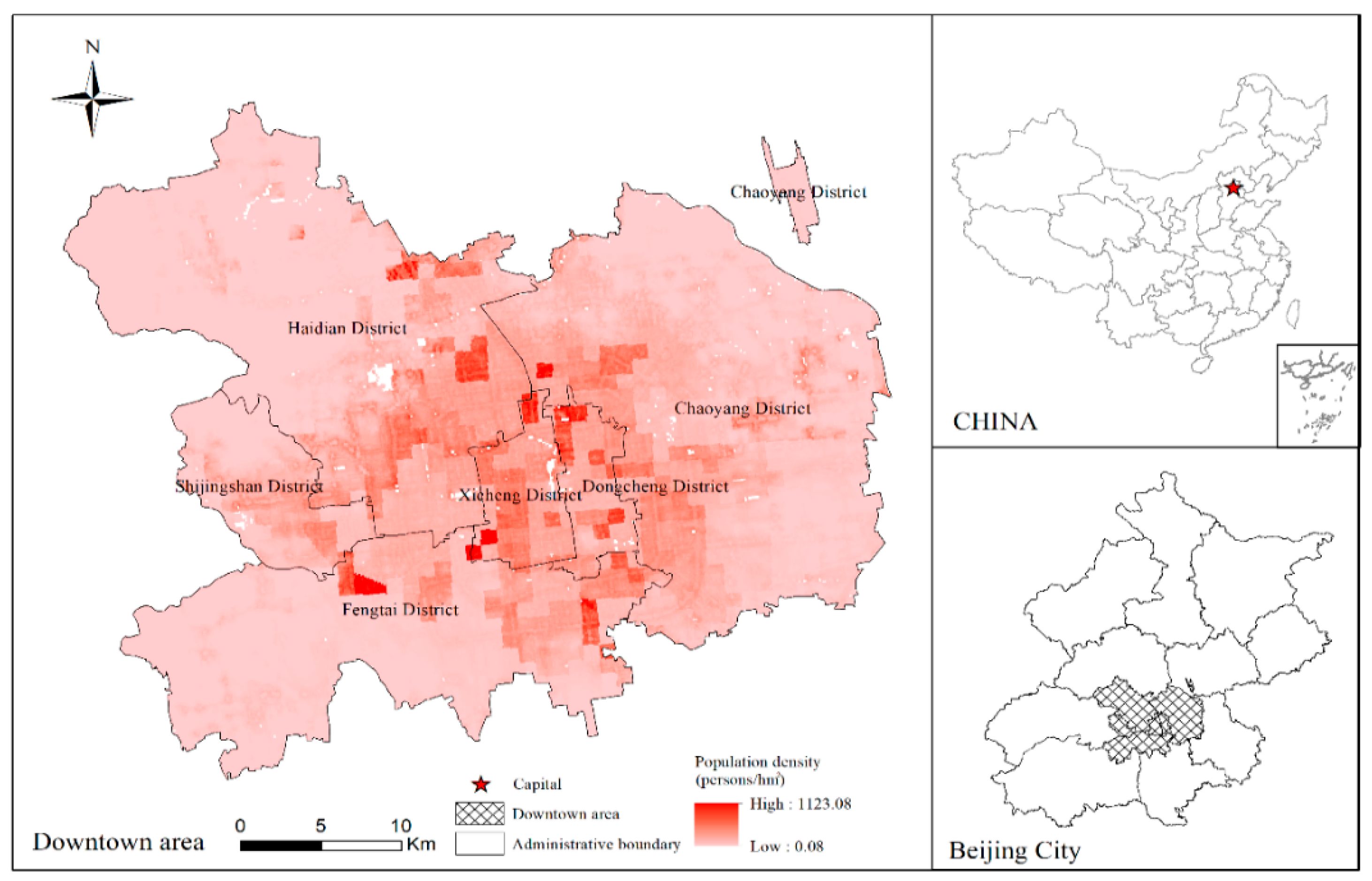


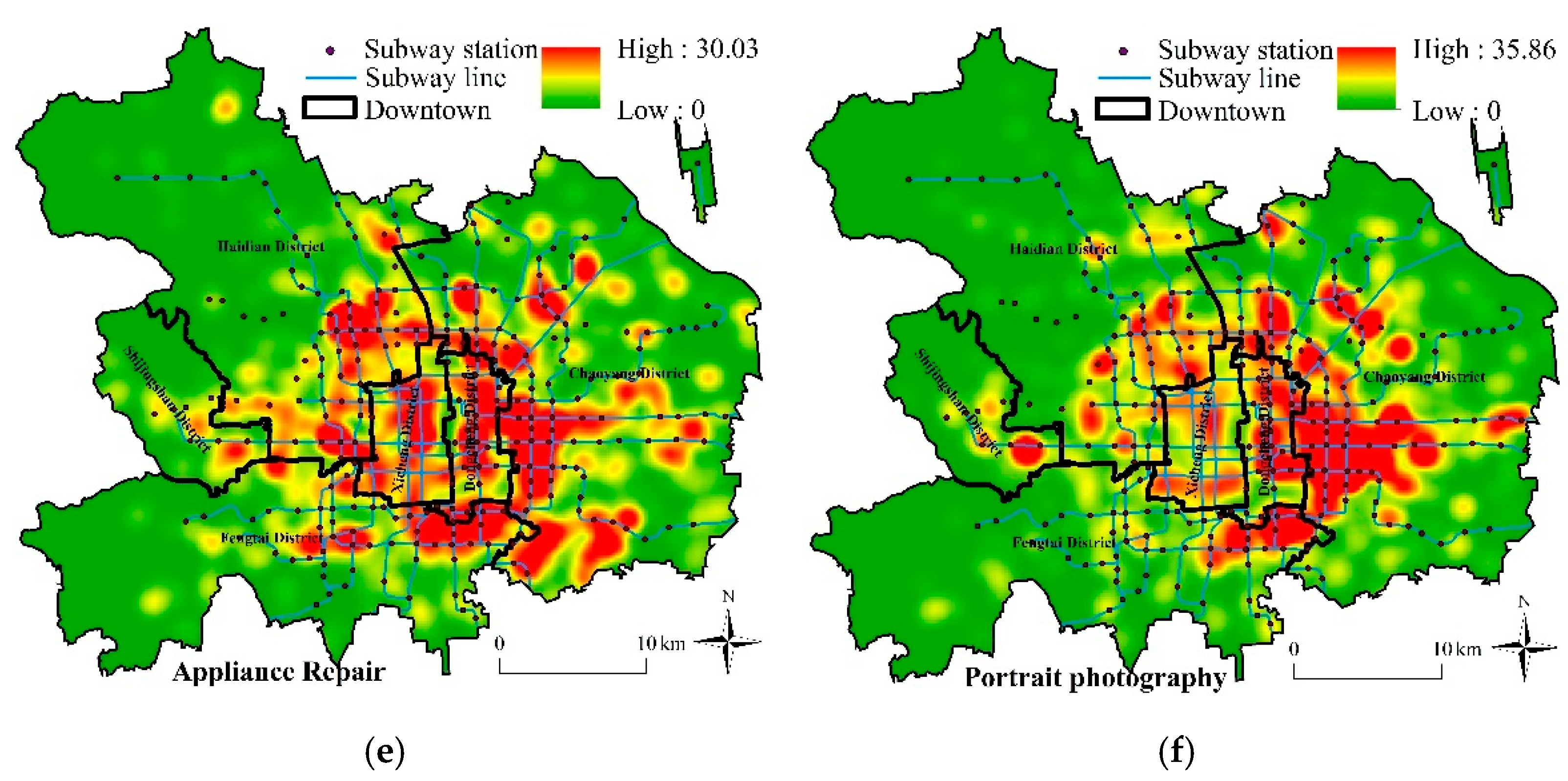

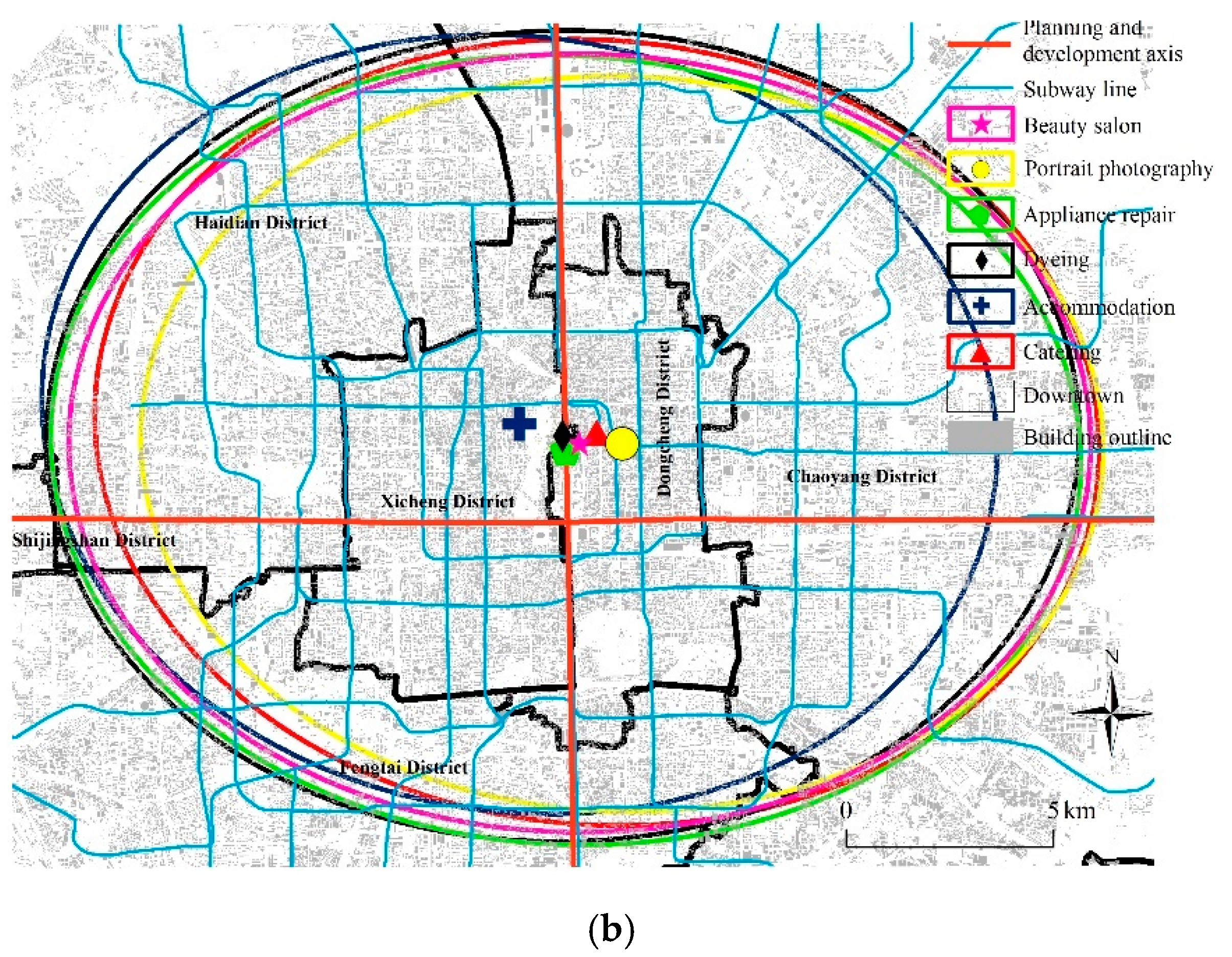
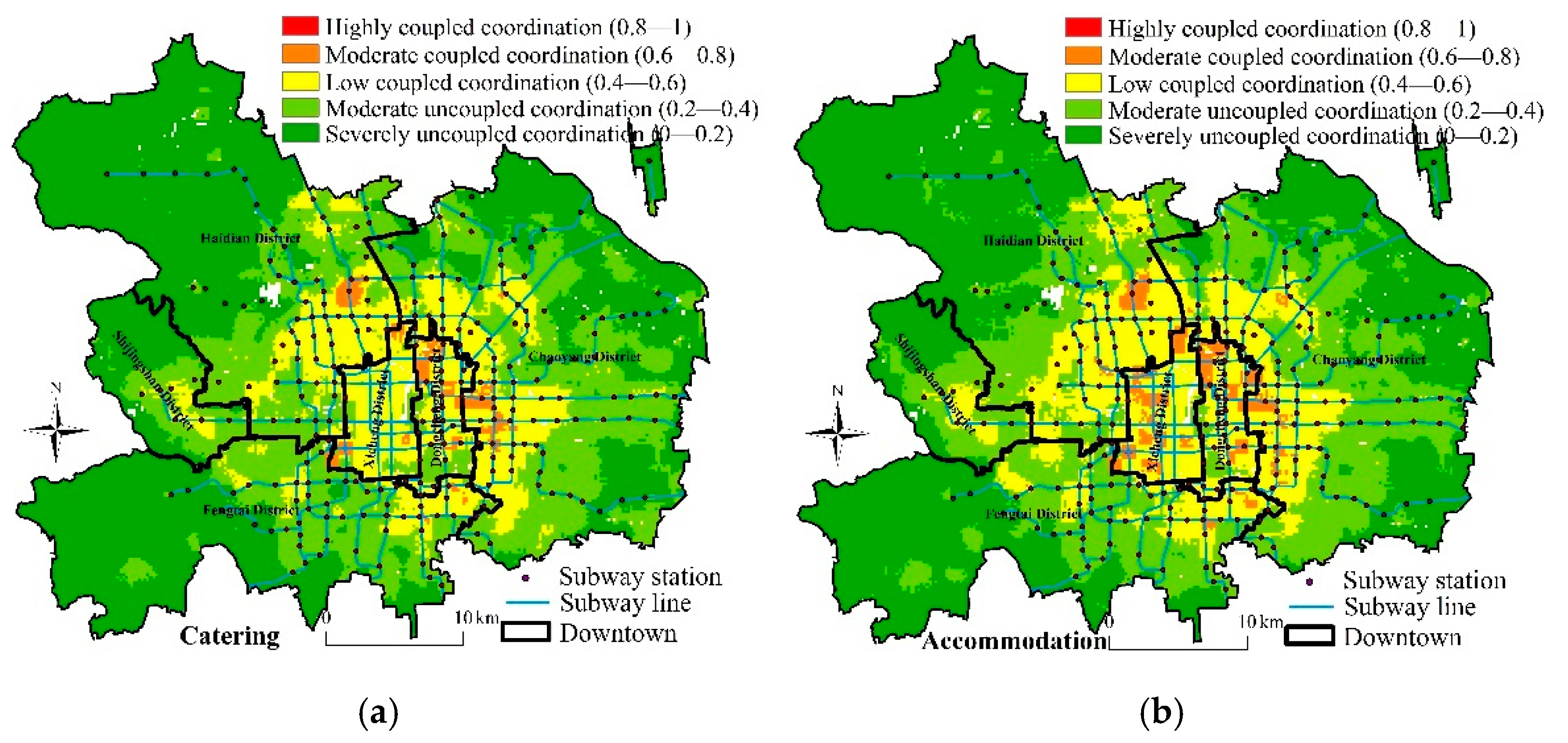
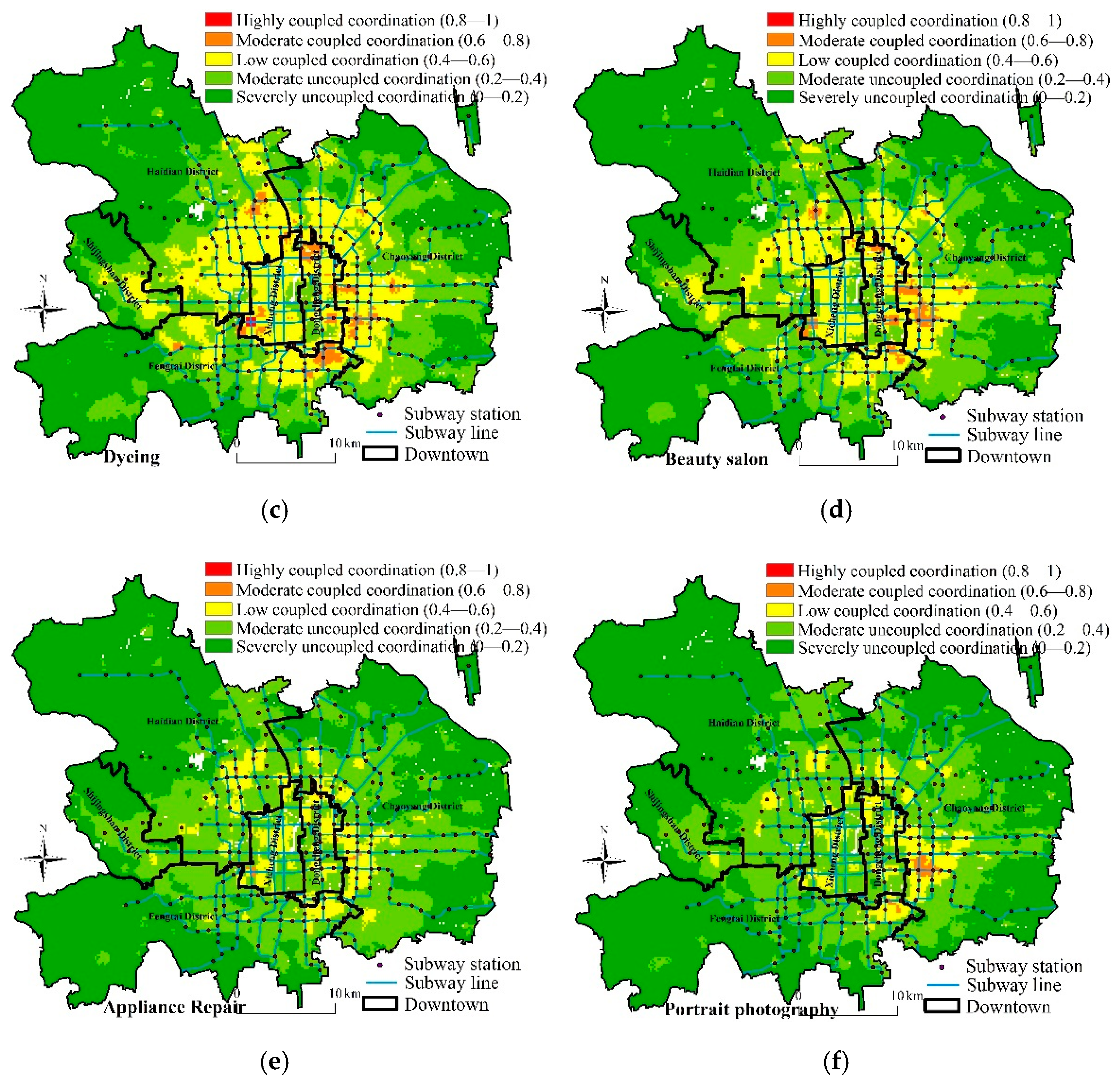
| D | Coupling Coordination State |
|---|---|
| 0.8 ≤ D 1 | Highly coupled coordination |
| 0.6 ≤ D 0.8 | Moderate coupled coordination |
| 0.4 ≤ D 0.6 | Low coupled coordination |
| 0.2 ≤ D 0.4 | Moderate uncoupled coordination |
| 0 ≤ D 0.2 | Severely uncoupled coordination |
| Category | Content | Number | Proportion (%) |
|---|---|---|---|
| Catering | Chinese restaurant, foreign restaurant, casual restaurant, cold drink shop, dessert shop, fast food restaurant, coffee shop, pastry shop, tea house, etc. | 42,530 | 51.4362 |
| Accommodation | Residential areas, hotels, tourist hotels, business residences, and commercial and residential buildings, etc. | 15,677 | 18.9599 |
| Dyeing | Laundry | 2204 | 2.6655 |
| Beauty salons | Beauty salon store | 17,239 | 20.8490 |
| Appliance Repair | Appliance repair store | 2421 | 2.9280 |
| Portrait photography | Photo print store | 2614 | 3.1614 |
| Total | 82,685 | 100 |
| Name | Average Observation Distance (di) | Expected Average Distance (de) | Nearest Neighbour Index (R) | Z-Score |
|---|---|---|---|---|
| Catering | 34.625 | 108.3 | 0.32 | −268.393 |
| Accommodation | 116.455 | 173.598 | 0.671 | −78.846 |
| Dyeing | 295.407 | 440.337 | 0.671 | −29.561 |
| Beauty salons | 61.962 | 167.085 | 0.371 | −158.032 |
| Appliance Repair | 249.173 | 416.087 | 0.599 | −37.761 |
| Portrait photography | 223.872 | 383.432 | 0.584 | −40.702 |
| Category | Centre Longitude (°) | Centre Latitude (°) | Perimeter (km) | Area (km2) | Length of Long Axis (km) | Length of Short Axis (km) | Azimuth (°) |
|---|---|---|---|---|---|---|---|
| Catering | 116.40E | 39.93N | 68.06 | 360.23 | 12.13 | 9.46 | 95.16 |
| Accommodation | 116.38E | 39.93N | 65.83 | 339.03 | 11.56 | 9.33 | 98.93 |
| Dyeing 1 | 116.39E | 39.92N | 70.10 | 382.61 | 12.46 | 9.78 | 88.76 |
| Beauty salon | 116.39E | 39.92N | 68.50 | 363.18 | 12.32 | 9.38 | 90.15 |
| Appliance repair | 116.39E | 39.92N | 69.23 | 371.36 | 12.43 | 9.51 | 93.58 |
| Portrait photography | 116.41E | 39.92N | 64.60 | 323.26 | 11.60 | 8.87 | 91.66 |
Publisher’s Note: MDPI stays neutral with regard to jurisdictional claims in published maps and institutional affiliations. |
© 2022 by the authors. Licensee MDPI, Basel, Switzerland. This article is an open access article distributed under the terms and conditions of the Creative Commons Attribution (CC BY) license (https://creativecommons.org/licenses/by/4.0/).
Share and Cite
Xu, Z.; Niu, L.; Zhang, Z.; Huang, J.; Lu, Z.; Huang, Y.; Wen, Y.; Li, C.; Gu, X. Sustainable Development of Life Service Resources: A New Framework Based on GIScience and Spatial Justice. Remote Sens. 2022, 14, 2031. https://doi.org/10.3390/rs14092031
Xu Z, Niu L, Zhang Z, Huang J, Lu Z, Huang Y, Wen Y, Li C, Gu X. Sustainable Development of Life Service Resources: A New Framework Based on GIScience and Spatial Justice. Remote Sensing. 2022; 14(9):2031. https://doi.org/10.3390/rs14092031
Chicago/Turabian StyleXu, Ze, Lu Niu, Zhengfeng Zhang, Jing Huang, Zhaodi Lu, Yufan Huang, Yangyang Wen, Chu Li, and Xiaokun Gu. 2022. "Sustainable Development of Life Service Resources: A New Framework Based on GIScience and Spatial Justice" Remote Sensing 14, no. 9: 2031. https://doi.org/10.3390/rs14092031
APA StyleXu, Z., Niu, L., Zhang, Z., Huang, J., Lu, Z., Huang, Y., Wen, Y., Li, C., & Gu, X. (2022). Sustainable Development of Life Service Resources: A New Framework Based on GIScience and Spatial Justice. Remote Sensing, 14(9), 2031. https://doi.org/10.3390/rs14092031








